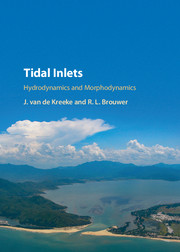Book contents
- Frontmatter
- Contents
- Preface
- 1 Introduction
- 2 Geomorphology
- 3 Sand Transport Pathways
- 4 Sand Transport and Sand Bypassing at Selected Inlets
- 5 Empirical Relationships
- 6 Tidal Inlet Hydrodynamics; Excluding Depth Variations with Tidal Stage
- 7 Tidal Inlet Hydrodynamics; Including Depth Variations with Tidal Stage
- 8 Cross-Sectional Stability of a Single Inlet System
- 9 Cross-Sectional Stability of a Double Inlet System, Assuming a Uniformly Varying Basin Water Level
- 10 Cross-Sectional Stability of a Double Inlet System, Assuming a Spatially Varying Basin Water Level
- 11 Morphodynamic Modeling of Tidal Inlets Using a Process-Based Simulation Model
- 12 Morphodynamic Modeling of Tidal Inlets Using an Empirical Model
- 13 River Flow and Entrance Stability
- 14 Engineering of Tidal Inlets
- References
- Index
6 - Tidal Inlet Hydrodynamics; Excluding Depth Variations with Tidal Stage
Published online by Cambridge University Press: 04 July 2017
- Frontmatter
- Contents
- Preface
- 1 Introduction
- 2 Geomorphology
- 3 Sand Transport Pathways
- 4 Sand Transport and Sand Bypassing at Selected Inlets
- 5 Empirical Relationships
- 6 Tidal Inlet Hydrodynamics; Excluding Depth Variations with Tidal Stage
- 7 Tidal Inlet Hydrodynamics; Including Depth Variations with Tidal Stage
- 8 Cross-Sectional Stability of a Single Inlet System
- 9 Cross-Sectional Stability of a Double Inlet System, Assuming a Uniformly Varying Basin Water Level
- 10 Cross-Sectional Stability of a Double Inlet System, Assuming a Spatially Varying Basin Water Level
- 11 Morphodynamic Modeling of Tidal Inlets Using a Process-Based Simulation Model
- 12 Morphodynamic Modeling of Tidal Inlets Using an Empirical Model
- 13 River Flow and Entrance Stability
- 14 Engineering of Tidal Inlets
- References
- Index
Summary
Introduction
The dynamics of the flow in the inlet are described by the equation for uniform unsteady open channel flow. Variations in depth with tidal stage are neglected. The dynamic equation is complemented with a continuity condition that assumes a pumping mode for the back-barrier lagoon, i.e., the water level in the back-barrier lagoon fluctuates uniformly. Although these are simplifications, the advantage is that they allow relatively simple analytical solutions that are helpful in identifying mechanisms responsible for phenomena such as resonance, tidal choking and generation of (odd) overtides. As examples, analytical solutions by Keulegan (1951, 1967) and Mehta and Özsoy (1978) are presented. Results of the analytical solutions are applied to a representative inlet and compared with numerical results.
Inlet Schematization
The tidal inlet system is schematized to an inlet and a back-barrier lagoon (Fig. 6.1). The inlet connects the back-barrier lagoon and the ocean. Its geometry is simplified to a prismatic channel with diverging sections at both ends. The backbarrier lagoon is schematized to a basin with uniform depth. Referring to Chapter 2, in the real world inlets have varying widths and depths and back-barrier lagoons are characterized by tidal flats and marsh areas. Therefore, the schematization presented in Fig. 6.1 is only a rough representation of an actual inlet.
Governing Equations and Boundary Condition
Dimensional Equations
In deriving the governing equations, the major assumptions are 1) one-dimensional unsteady uniform flow in the inlet, 2) a uniformly fluctuating water level in the basin (pumping or Helmholz mode) and 3) negligible variations in cross-sectional area of the inlet and basin surface area with tidal stage. With these assumptions, the equation for the flow in the inlet is (Appendix 6.A):
In this equation u is the cross-sectionally averaged velocity, positive in the flood direction, L is length of the prismatic part of the inlet, g is gravity acceleration, t is time, F = f /8 where f is the Darcy–Weisbach friction factor, R is hydraulic radius, m is entrance/exit loss coefficient, η0 is the ocean tide and ηb is the basin tide.
Information
- Type
- Chapter
- Information
- Tidal InletsHydrodynamics and Morphodynamics, pp. 44 - 60Publisher: Cambridge University PressPrint publication year: 2017
